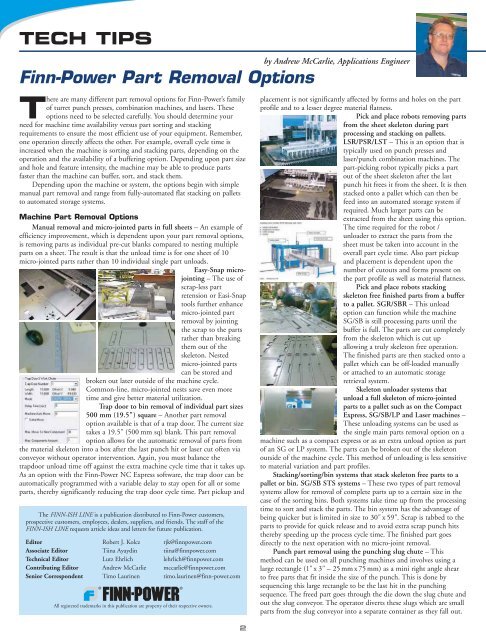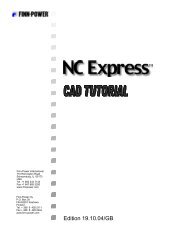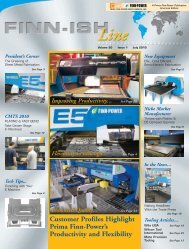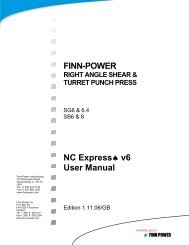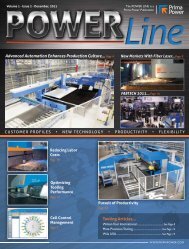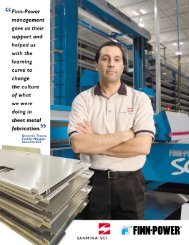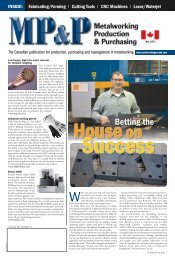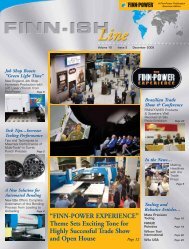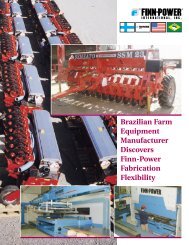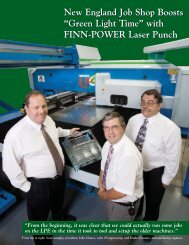volume 18 - issue 1 - Finn-Power International, Inc.
volume 18 - issue 1 - Finn-Power International, Inc.
volume 18 - issue 1 - Finn-Power International, Inc.
You also want an ePaper? Increase the reach of your titles
YUMPU automatically turns print PDFs into web optimized ePapers that Google loves.
TECH TIPS<br />
<strong>Finn</strong>-<strong>Power</strong> Part Removal Options<br />
There are many different part removal options for <strong>Finn</strong>-<strong>Power</strong>’s family<br />
of turret punch presses, combination machines, and lasers. These<br />
options need to be selected carefully. You should determine your<br />
need for machine time availability versus part sorting and stacking<br />
requirements to ensure the most efficient use of your equipment. Remember,<br />
one operation directly affects the other. For example, overall cycle time is<br />
increased when the machine is sorting and stacking parts, depending on the<br />
operation and the availability of a buffering option. Depending upon part size<br />
and hole and feature intensity, the machine may be able to produce parts<br />
faster than the machine can buffer, sort, and stack them.<br />
Depending upon the machine or system, the options begin with simple<br />
manual part removal and range from fully-automated flat stacking on pallets<br />
to automated storage systems.<br />
Machine Part Removal Options<br />
Manual removal and micro-jointed parts in full sheets – An example of<br />
efficiency improvement, which is dependent upon your part removal options,<br />
is removing parts as individual pre-cut blanks compared to nesting multiple<br />
parts on a sheet. The result is that the unload time is for one sheet of 10<br />
micro-jointed parts rather than 10 individual single part unloads.<br />
Easy-Snap microjointing<br />
– The use of<br />
scrap-less part<br />
retension or Easi-Snap<br />
tools further enhance<br />
micro-jointed part<br />
removal by jointing<br />
the scrap to the parts<br />
rather than breaking<br />
them out of the<br />
skeleton. Nested<br />
micro-jointed parts<br />
can be stored and<br />
broken out later outside of the machine cycle.<br />
Common-line, micro-jointed nests save even more<br />
time and give better material utilization.<br />
Trap door to bin removal of individual part sizes<br />
500 mm (19.5" ) square – Another part removal<br />
option available is that of a trap door. The current size<br />
takes a 19.5" (500 mm sq) blank. This part removal<br />
option allows for the automatic removal of parts from<br />
the material skeleton into a box after the last punch hit or laser cut often via<br />
conveyor without operator intervention. Again, you must balance the<br />
trapdoor unload time off against the extra machine cycle time that it takes up.<br />
As an option with the <strong>Finn</strong>-<strong>Power</strong> NC Express software, the trap door can be<br />
automatically programmed with a variable delay to stay open for all or some<br />
parts, thereby significantly reducing the trap door cycle time. Part pickup and<br />
The FINN-ISH LINE is a publication distributed to <strong>Finn</strong>-<strong>Power</strong> customers,<br />
prospective customers, employees, dealers, suppliers, and friends. The staff of the<br />
FINN-ISH LINE requests article ideas and letters for future publication.<br />
Editor Robert J. Kolcz rjk@finnpower.com<br />
Associate Editor Tiina Ayaydin tiina@finnpower.com<br />
Technical Editor Lutz Ehrlich lehrlich@finnpower.com<br />
Contributing Editor Andrew McCarlie mccarlie@finnpower.com<br />
Senior Correspondent Timo Laurinen timo.laurinen@finn-power.com<br />
All registered trademarks in this publication are property of their respective owners.<br />
2<br />
by Andrew McCarlie, Applications Engineer<br />
placement is not significantly affected by forms and holes on the part<br />
profile and to a lesser degree material flatness.<br />
Pick and place robots removing parts<br />
from the sheet skeleton during part<br />
processing and stacking on pallets.<br />
LSR/PSR/LST – This is an option that is<br />
typically used on punch presses and<br />
laser/punch combination machines. The<br />
part-picking robot typically picks a part<br />
out of the sheet skeleton after the last<br />
punch hit frees it from the sheet. It is then<br />
stacked onto a pallet which can then be<br />
feed into an automated storage system if<br />
required. Much larger parts can be<br />
extracted from the sheet using this option.<br />
The time required for the robot /<br />
unloader to extract the parts from the<br />
sheet must be taken into account in the<br />
overall part cycle time. Also part pickup<br />
and placement is dependent upon the<br />
number of cutouts and forms present on<br />
the part profile as well as material flatness.<br />
Pick and place robots stacking<br />
skeleton free finished parts from a buffer<br />
to a pallet. SGR/SBR – This unload<br />
option can function while the machine<br />
SG/SB is still processing parts until the<br />
buffer is full. The parts are cut completely<br />
from the skeleton which is cut up<br />
allowing a truly skeleton free operation.<br />
The finished parts are then stacked onto a<br />
pallet which can be off-loaded manually<br />
or attached to an automatic storage<br />
retrieval system.<br />
Skeleton unloader systems that<br />
unload a full skeleton of micro-jointed<br />
parts to a pallet such as on the Compact<br />
Express, SG/SB/LP and Laser machines –<br />
These unloading systems can be used as<br />
the single main parts removal option on a<br />
machine such as a compact express or as an extra unload option as part<br />
of an SG or LP system. The parts can be broken out of the skeleton<br />
outside of the machine cycle. This method of unloading is less sensitive<br />
to material variation and part profiles.<br />
Stacking/sorting/bin systems that stack skeleton free parts to a<br />
pallet or bin. SG/SB STS systems – These two types of part removal<br />
systems allow for removal of complete parts up to a certain size in the<br />
case of the sorting bins. Both systems take time up from the processing<br />
time to sort and stack the parts. The bin system has the advantage of<br />
being quicker but is limited in size to 30" x59" . Scrap is tabbed to the<br />
parts to provide for quick release and to avoid extra scrap punch hits<br />
thereby speeding up the process cycle time. The finished part goes<br />
directly to the next operation with no micro-joint removal.<br />
Punch part removal using the punching slug chute – This<br />
method can be used on all punching machines and involves using a<br />
large rectangle (1" x3" – 25 mm x 75 mm) as a mini right angle shear<br />
to free parts that fit inside the size of the punch. This is done by<br />
sequencing this large rectangle to be the last hit in the punching<br />
sequence. The freed part goes through the die down the slug chute and<br />
out the slug conveyor. The operator diverts these slugs which are small<br />
parts from the slug conveyor into a separate container as they fall out.


